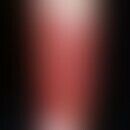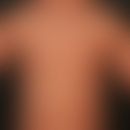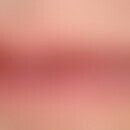Synonym(s)
HistoryThis section has been translated automatically.
Riecke 1900
DefinitionThis section has been translated automatically.
Most severe form of autosomal recessive congenital ichthyosis (ARCI). S.u. Ichthyoses.
You might also be interested in
Occurrence/EpidemiologyThis section has been translated automatically.
Very rare form of ichthyosis with a prevalence of 1/1.0 million people
EtiopathogenesisThis section has been translated automatically.
Recessive nonsense mutation in the ABCA12 gene located on chromosome 2q34. The ABCA12 gene encodes a protein called the ATP-binding cassette (ABC) transporter. This protein is involved in lipid transport from lamellar granules to the apical membrane of keratinocytes in the statum granulosum. It is likely that the mutation, either via alteration of the major nucleotide-binding domain or the transmembrane domain of the ABCA12 protein, results in a significant loss of lipid barrier function, leading to the severe ichthyotic skin condition.
Less severe missense mutations of the ABCA12 gene result in a milder variant of autosomal recessive congenital ichthyoses (see ACRI spectrum).
ClinicThis section has been translated automatically.
Children are born with extreme, already intrauterine keratinization with armor-like horn plates and deep skin tears (lamellar ichthyosis). The armour-like armour severely impairs the mobility of the infants and also considerably restricts their ability to breathe and eat. The harlequin fetus is born with a flat nose, bulging lips, ectropionated eyelids. Further infestation of oral and genital mucous membrane.
HistologyThis section has been translated automatically.
DiagnosisThis section has been translated automatically.
TherapyThis section has been translated automatically.
External therapyThis section has been translated automatically.
It is important to lubricate the skin several times a day (e.g. kerosene subliq., Linola fat). If the skin is torn, grease gauze with antiseptic additives such as chlorhexidine (e.g. Bactigras gauze dressing). Oil-containing baths and antiseptic additives such as chlorhexidine. Externals containing salicylic acid for extreme hyperkeratotic areas are controversial because of resorptive toxicity; better short term for such areas are up to 10% urea ointments.
Local treatment with tazarotene can be applied to circumscribed areas of skin (< 2% of body surface). S.a.u. Ichthyosis vulgaris, autosomal dominant.
Internal therapyThis section has been translated automatically.
Etretinate therapy (1-3 mg/day in slowly decreasing dosage) is the only medication described as effective. Onset in the first days of life.
Causes of death of initially surviving babies are especially sudden septicemia with rapid deterioration. Therefore, prophylactic broad-spectrum antibiotics, regular smears of the skin, blood checks for bacteremia, and the fastest possible use of antibiotics according to antibiogram, are necessary if infection is suspected.
Progression/forecastThis section has been translated automatically.
50% of children die before or shortly after birth due to respiratory insufficiency, heat/water balance disorders and septicaemia. The clinical picture later changes to inflammatory exfoliative ichthyosis and erythroderma.
In long-term survivors the skin armour recedes somewhat. Generalised, coarse lamellar scaling with pronounced inflammatory symptoms (erythrodermia) is observed.
LiteratureThis section has been translated automatically.
- Akiyama M et al (2003) The clinical spectrum of nonbullous congenital ichthyosiform erythroderma and lamellar ichthyosis. Clin Exp Dermatol 28: 235-240
- Akiyama M et al (2005) Mutations in lipid transporter ABCA12 in harlequin ichthyosis and functional recovery by corrective gene transfer. J Clin Invest 115:1777-1784.
- Chan YC (2003) Harlequin ichthyosis in association with hypothyroidism and juvenile rheumatoid arthritis. Pediatr Dermatol 20: 421-426.
- Prasad RS et al (1994) Management and follow-up of harlequin siblings. Br J Dermatol 130: 650-653.
- Rao J (2003) Images in clinical medicine. The harlequin color change. N Engl J Med 349: 968
- Roberts LJ (1989) Long-term survival of a harlequin fetus. J Am Acad Dermatol 21: 335-339.
- Traupe H et al (2014) The nonsyndromal ichthyoses-current status. JDDG 12: 109-120
- Virolainen E et al (2001) Ultrastructural features resembling those of harlequin ichthyosis in patients with severe congenital ichthyosiform erythroderma. Br J Dermatol 145: 480-483
- Ward PS et al (1989) Successful treatment of a harlequin fetus. Arch Dis Child 64: 1309-11
- Smith RW (1880) A case of intrauterine ichthyosis. Am J Obstet Gynec 13: 458-461.
Incoming links (6)
Abca12 gene; Abc transporters; Diffuse keratosis maligna; Epidermolytic ichthyosis; Hyperkeratosis universalis congenita; Self-improving congenital ichthyosis;Outgoing links (13)
ABCA12 Gene; Antibiogram; Antibiotics; Autosomal recessive congenital ichthyosis; Chlorhexidine; Ichthyosis (overview); Ichthyosis vulgaris; Proliferative hyperkeratosis; Retinoids; Salicylic acid; ... Show allDisclaimer
Please ask your physician for a reliable diagnosis. This website is only meant as a reference.





